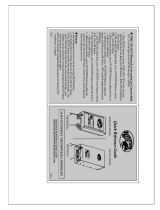
2
DMX IN
Optional
Aria transmitter
INTRODUCTION
WELCOME
Welcome to the Dyna Drum SO range from Acclaim Lighting. These rugged LED-powered
fixtures are designed to replace traditional external flood lights while using a fraction of the
power. The Dyna Drum SO range consists of three main variants:
• White - 2700K, 3000K, 3500K, 4000K or 5700K,
• Single Color Series - RGBW (W=4000K), RGBA, RGBAW (W=4000K) or DW (2400K-5500K)*
• Color - RGBW where: QS (W=3000K), QW4 (W=4000K) or QW6 (W=6000K)
External control using the DMX-512A is supported either through direct cable connection or
via the in-built Aria™ wireless DMX receiver (transmitter available as an optional extra).
A clear daylight-readable OLED
touch-screen user display provides
access to a comprehensive
configuration menu system (see
page 16). Alternatively, the
industry standard RDM (Remote
Device Management) format can be
used to configure the DMX start address and wireless channel (see page 25).
Dyna Drum SO fixtures feature automated operation when light levels fall below a certain
level together with a timer for auto shut off. The internal auto-sensing power supply can
accept mains inputs between 100 to 277VAC at 50 or 60Hz. Total power consumption
ranges from 135 to 150W depending on the model.
All models can be specified with Outdoor Link System
connectors pre-fitted instead of bare tails. OLS greatly
simplifies the task of distributing power and control to
multiple fixtures (see pages 4 and 13).
* Single Color Series (SCS) models feature individual single-color emitters (Red, Green, Blue, White
and/or Amber) which operate in unison to produce the required effect (as opposed to the Color
models which use combined Chip On Board (COB) quad RGBW emitters.
SAFETY
• When fixtures are mounted off-ground, ensure they are securely fitted to an appropriate
mounting surface.
• Ensure that the power input is supplied from a correctly fused, earthed and
environmentally protected location.
MAINTENANCE
CAUTION: Always isolate mains power before starting maintenance operations.
• Ensure that all mounting (and device) screws/bolts are fully tight and free of corrosion.
• Ensure there is no deformation to the housing, lenses or fixing points.
• Check that all power supply cables are free from physical damage or material fatigue.
• Use only genuine spare parts supplied by Acclaim Lighting.
CLEANING
• Use a moist, lint-free cloth when cleaning each fixture.
• Never use alcohol or solvents.
OUTDOORLINK
























